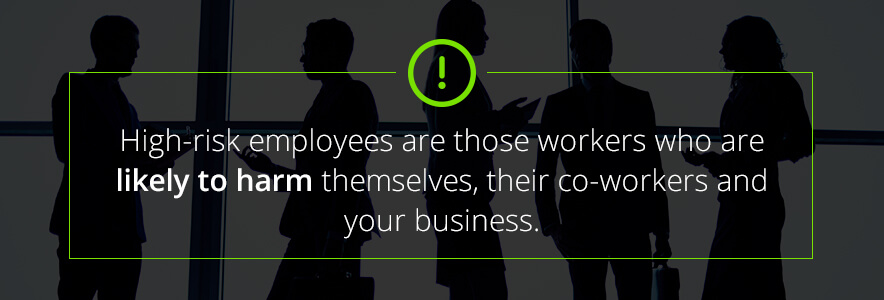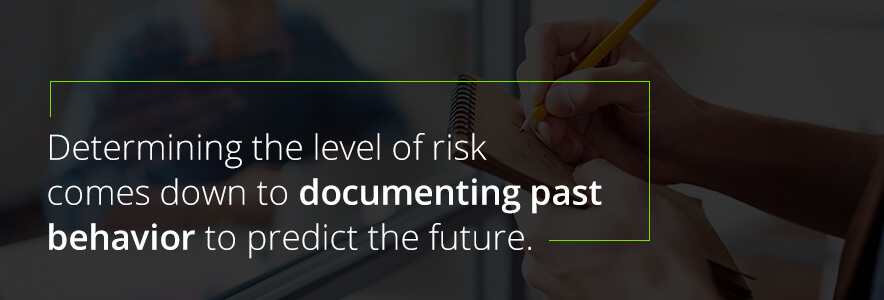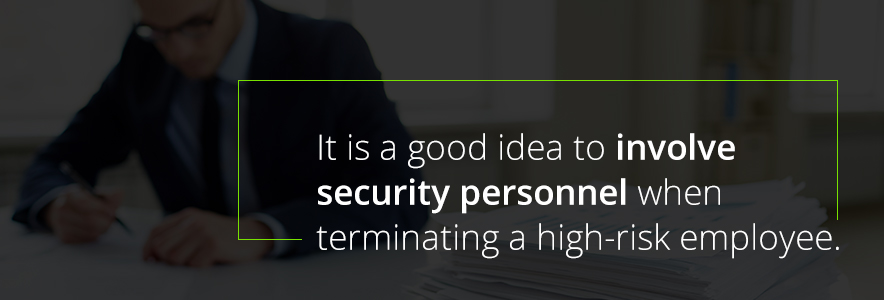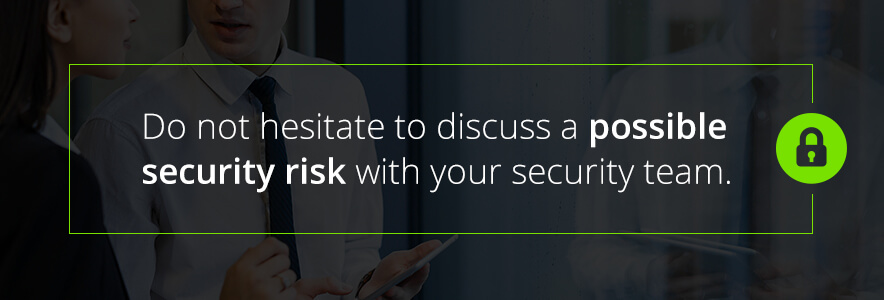
How to Identify and Manage High-Risk and Violent Employees
August 16, 2019
Every business owner wants to create a safe environment for their employees, and most people might think that “safety” applies mostly to industrial fields when employees work with heavy equipment doing physically demanding tasks. However, even in businesses where employees are not responsible for heavy lifting or working with machinery, there are safety risks.
One such risk is the potential for high-risk and violent employees. Identifying and managing those employees can help you ensure they have an ideal working environment and that the workplace is safe for everyone else as well. Read on to learn more about how to prevent hiring high-risk employees and how to fire a violent employee.
How to Identify High-Risk Employees
What is a high-risk employee? They are those workers who are more likely to harm themselves, their co-workers and your business. Most employees do not set out with malicious intentions, but circumstances in their lives may push them to a breaking point, and their aggressions may be taken out at work. One key to identifying employees who are a high-risk for violence in the workplace is to get to know them as well as you can.
As an employer, you need to maintain a connection to the people on your team. Getting to know your employees and understanding their personalities is an important part of being a good boss. When you pay attention to your employees, you can sense when they are having a bad day. You may also learn that there is something serious going on in their personal lives that could be putting extra pressure on them.

Personal tragedies like divorce or a death in the family can push people to their breaking point. The issue does not have to be work-related to spark violence on the job, either. Everyone deals with stress a little differently. If one of your employees is prone to act out when they’re frustrated, and they’re facing a personal crisis, you may need to keep a closer eye on them for a while.
However, not all stressed employees are dangerous. If you want to know how to spot a potentially violent employee, here are some warning signs to watch for:
- A drastic, negative change in behavior
- Intense disruptions to the work environment
- Threats to others or the company
- Alarming social media posts
- Difficulty getting along with team members
- Control/power issues
- Constant anger
It is important to note that bad things happen to good employees. One of the biggest warning signs is when a good employee suddenly adopts one of these behaviors. A negative change in performance or behavior could indicate trouble is coming.
Learn More About Our Employee Termination Services
The other type of high-risk employee is the quiet one who does not make any trouble. Social interaction is an important sign of a well-adjusted individual. Not everyone is outgoing, but in a work environment, most people form interpersonal bonds. The employee who does not connect with anyone may be brooding.
Getting to know your employees and staying connected with them is one of the best ways to identify potential problems. It is also a good way to keep your team’s morale up and their work performance high. Direct communication with your employees will solve a lot of problems before they even get started.
How to Determine the Risk Level of an Employee
As in any potential crisis situation, risk assessment is important. When you have an employee displaying warning signs of potential violent behavior, you need to figure out how serious the threat is. Not everyone will behave violently, and some problem behaviors can be corrected with proper training and follow-up.
Where there is a potential for violence, though, you want to err on the side of caution. You need to be sure you don’t do anything to escalate a potentially negative situation.
Determining the level of risk comes down to documenting past behavior to predict the future. Take a look at the number of incidents an employee has been involved in. How many times do customers complain about an employee’s attitude or co-workers report a problem? How severe were those incidents? If you can determine a pattern of behavior with an escalation in severity, you can better predict how much at-risk an employee may be.

What to Do About a High-Risk Employee
Hiring an employee is a large upfront expenditure of time and money. When you have to fire someone, you do not get a return on that investment. Starting over with a new employee requires another investment in wages and training, so unless an employee is stealing from you or posing an immediate threat to your team, firing is not usually financially advantageous. You’ll likely want to look at other options first.
One method is to create a rehabilitation plan to address the problems you see with a high-risk employee. Ideally, you want to work with that employee to improve their performance on the job, including their attitude. That might require talking with the employee about what is going on outside of work and helping them realize how it’s affecting their job. These conversations are delicate, and rehabilitating a high-risk employee requires patience.
In the meantime, you still have a responsibility to the rest of your team to maintain a safe work environment. If there is possible violence involved, the security of your business is also at stake. You will need to work with your whole staff to re-enforce your expectations and strengthen their loyalty to you and the business.
While these changes are taking place, be sure to also secure the work environment. Additional security can help you get through this transition without incident. If you are concerned about appearances, incognito security personnel can be hired to blend in around the office. They can gather information about the risk level while serving to protect your employees and your business in the event of any potential violence.
How to Safely Terminate High-Risk Employees
Terminating a dangerous employee can be a delicate situation, but when handled right, the risk ends as the employee walks out the door.
The steps to firing a high-risk employee include:
- Setting up a private meeting with a witness
- Locking the employee out of the network and the building
- Taking any threats seriously
- Engaging security to escort the employee out
- Increasing security for the next several days
Contact Us For Increased Security
If you have to fire someone, even if they are not considered a violence risk, it is a good idea to make the break quickly and thoroughly. Plan the termination for later in the day when your former employee can leave the building inconspicuously. You do not want to shame an employee or give them a pulpit, especially if they might be prone to violence.
Always fire an employee in a private meeting with at least one other person in the room. If you do not have an HR manager, include some other confidential person from your company, so there is a non-threatening witness to the conversation. Have the employee’s access to your computer network shut off and any security codes they have canceled when they enter the meeting. Be prepared to allow the fired employee to collect their personal things under supervision and escort them from the building.

It is a good idea to involve security personnel when terminating a high-risk employee. A security guard can escort your fired employee through the building to get their personal items and then lead them out the door. This measure may seem extreme, but it will protect everyone who is still working, you and your business. Being fired is the ultimate humiliation for some people, and they may react with violence. It is not unheard of for fired employees to steal or damage company property on the way out the door.
You should also increase security around your business for several days after you fire a high-risk employee. If that person is angry and prone to violence, they might try to retaliate against you or the company. Now, while the rest of your team is working, this individual has free time. Getting them out of the organization was the first step in protecting your team, but you need to be sure they are going to stay away.
Preventive Measures — How to Avoid Hiring a High-Risk Employee
No one wants to deal with violence in the workplace. Firing high-risk employees is stressful and can be avoided if you do not hire these people in the first place. Of course, during the hiring process, you can’t predict the future, but there are some things you can do to weed out potentially violent employees.
Look for these signs of a high-risk employee in the interview:
- Angry — The applicant expresses dislike or distrust for former co-workers, bosses, family members or everyone in their lives.
- Blaming — When an applicant ascribes all of their failures to someone else on the team or the boss, they may be a high risk for violence.
- Controlling — In the interview, the applicant expresses a need to change other people’s opinions to match their own. They do not seem open to change and has an attitude of superiority.
- Trouble Connecting with Others — An applicant who has trouble getting along with others might be prone to violence and disruption in the work environment. Someone who describes their interactions with former co-workers in inappropriate terms or has unreasonable expectations of others could be high risk.
- Litigious — If the applicant has filed numerous grievances against former co-workers or bosses, that could be an indication they are high risk.
- Verbally violent — An applicant who expresses their opinions in violent terms or shows sympathy for the perpetrator of violence rather than the victim may be a high-risk hire.
- Vindictive — Expressing a desire for vindication against anyone is a sign of potential violent behavior. You may recognize this attitude when an applicant talks about a former boss.
- Paranoid — An applicant who thinks everyone is out to get them can be a high-risk hire. Listen for stories about former bosses or co-workers who wanted to get them in trouble or fired. This person is often in the center of upheaval at work.
Any of these signs could be cause for concern. A combination of several should tell you this person would be a high-risk hire. Use the interview to get to know as much as you can about the applicant. Ask open-ended questions to keep the applicant talking. The more they talk in the interview, the more you will learn about them. Do not discount your gut feelings about someone, either. If you feel uncomfortable around the person, your team members will probably feel the same way.

Even after you hire a new employee, continue to evaluate them. Be sure the training the new employee receives is thorough and covers expected conduct as well as job tasks.
Additionally, try to make your new hire feel welcome. If you integrate them with the rest of the team, the sense of involvement and camaraderie may help to diffuse potential negative situations. Your company culture should eventually subsume a new employee as well. If they continue to stand out in a negative way, though, you may want to keep an eye on them.
Always run a thorough background check before hiring a new employee. Past acts of violence can predict future problems. Generally, people who are prone to violence as a means of solving problems or working out their frustrations will continue to use those means. Do not assume that the job you offer will be so pleasant that this individual will not have anything negative to react to. People who are prone to violence always find something to be frustrated about.
What Action Should You Take If You Suspect a Person Is a Security Risk?
If you suspect there is a problem with an employee, taking the proper precautions can mean the difference between a positive outcome and a tragedy. Always rely on your security professionals to handle risks in your organization. That is what they are trained for. Your job is to identify potential risks based on your observations and interactions with your employees. As the boss, you are privy to information that others do not have.

Do not hesitate to discuss a possible security risk with your security team. You don’t have to make the judgment about taking action or not. The security guards will assess the information you give them, gather additional information if necessary, and come to you with their professional recommendation.
Running a business can be overwhelming, especially when you have to worry about high-risk employees and the safety and security of your staff. This is why you hire contractors to assist you with operations. A legal expert handles your liability issues. An accountant keeps track of your finances. Be sure you have a security expert to protect your staff and your business from the threat of violence.
